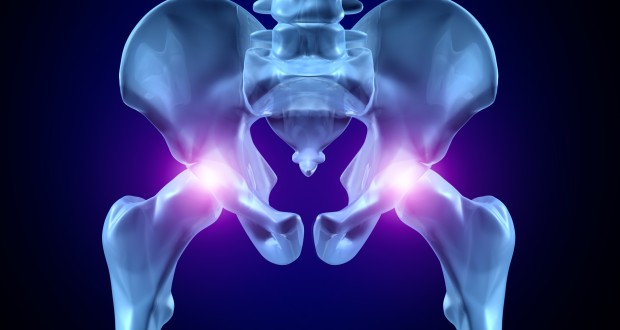Many older adults seem to constantly struggle with pain, be it in their knees, back or shoulders. One area that troubles a good number of people is our hips. Like other areas of the body, our hips are susceptible to the various types of wear and tear associated with aging. By taking proper care of your body, you can help insure that you won’t suffer from chronic hip pain in your later years.
Causes of Hip Pain
When you really study the hip joint, it becomes obvious that this part of your body was made to shoulder a heavy burden. The hip joint consists of a “ball” (technically, the top end of the femur bone) that moves around inside a bowl-shaped space known as a “socket.” Hence, the hip joint is categorized as a ball-and-socket joint. Virtually every time you move, whether it’s walking, jogging or getting into a chair, you rely on your hip joints to do the job. Consequentially, your hip joint socket is covered with a layer cartilage, preventing the femur and pelvis from grinding against each other.
Unfortunately, this cartilage isn’t immune to damage and decay. As with other joints, cartilage erosion goes hand in hand with joint pain. It is this scenario that usually triggers arthritis. In addition, all bones – the pelvis and femur included – are vulnerable to fractures if lacking key nutrients. If these problems weren’t enough, hip pain can also be caused by the following culprits:
Tendonitis – The body’s bones and muscles are held together by tissues known as tendons. If these tendons are overused, they can become inflamed, resulting in a pain-inducing condition called tendonitis. Tendonitis can strike joints all over the body, including the hip.
Muscle Strains – Like tendons, muscles can be injured if they are asked to do too much. Overburdened muscles can become inflamed muscles, leading to potentially chronic pain.
Bursitis – While tendonitis and strains are well-known maladies (and why not, considering how many people struggle with them), bursitis is a relatively obscure condition. Bursae are strategically placed fluid-filled sacs that prevent friction between tendons and bones. If they are overworked, bursae can be become inflamed and cause bursitis.
Cancer – By far the most serious condition on this list, tumors that either originate or spread to the hip bones can easily cause severe pain, along with other serious symptoms.
Prevention and Treatment
In many cases, overusing the body’s hip bones is the root cause of hip pain. It’s important to be aware of your body’s limits for physical endurance, and to act accordingly. It might also prove helpful to warm up before exercising. Hauling around excess pounds is bad for all of your body’s joints, so try adjusting your diet if you are overweight.
If you still find yourself struggling with hip pain, the following suggestions might be helpful:
- Wear shoes that have a thick layer of cushioning. Women should avoid high heels.
- Try keeping your hips level as often as possible. Many people unknowingly induce hip pain by elevating one hip higher than the other for a prolonged length of time. For example, you might aggravate your hip by running track in one direction for a long period of time, or by performing yard work on a slope.
- When climbing or descending a staircase, make sure to only use one step at a time. Lead with your strong leg on the way up, and the weaker leg on the way down.
While these measures can prevent hip problems and mitigate existing pain, many patients with chronic hip pain require medical treatment to alleviate their symptoms. Some people take supplements to rebuild withered cartilage in their hip joint; such supplements usually feature a potent mix of glucosamine and chrondroitin. Myofascial release treatments are another option; this form of treatment attempts to reduce pain by loosening tissues surrounding the hip, with the goal of realigning the hip joint. Myofascial release treatments are administered through messages, a technique that might cause initial discomfort before the patient experiences relief.
If these treatment methods are met with little success, a doctor might recommend physical therapy. Physical therapy usually requires a patient to perform a series of stretching and stretching exercises. If successful, this exercise regimen should rebuild the hip’s bones and adjacent tissues and tendons, rendering them more flexible. In turn, this improved range of motion allows the body to channel more nutrients to the hip via the bloodstream.
Hip replacements are usually the option of last resort. A doctor usually pursues this option after arthritis has thoroughly crippled the patient’s hip. The procedure replaces the “ball” of the hip joint (otherwise known as the top of the femur bone) with a metal ball. To prevent friction, a coating of plastic is attached to the socket. If necessary, the surgeon will also smooth any rough bone surfaces and remove damaged cartilage.
Hip pain can be serious problem, and can make performing routine activities exceedingly difficult. By avoiding some common mistakes, and making good use of all available treatment options, it’s possible to keep bothersome hip pain in check.
 Natural Knowledge 24/7 Educate yourself with nutrition, health and fitness knowledge.
Natural Knowledge 24/7 Educate yourself with nutrition, health and fitness knowledge.






